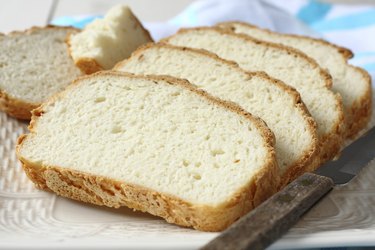
Tapioca flour, or tapioca starch, comes from the cassava plant. This gluten-free starch can help improve the flavor and texture of gluten-free baked goods. Gluten is responsible for building the structure of breads and other baked goods, giving these foods a characteristic chewy texture. Tapioca flour can help add body to your gluten-free recipes, making them feel like more traditional recipes.
Gluten-Free All-Purpose Flour
Video of the Day
For most of your baking needs, you can create a gluten-free all-purpose flour blend containing tapioca flour. Combine 1 part tapioca flour, 2 parts potato starch and 6 parts brown rice flour. When using this flour in traditional recipes, substitute an equal amount of the gluten-free blend for the amount of all-purpose flour.
Video of the Day
Gluten-Free Bread Flour
If you are making gluten-free bread, mix together 3 parts millet and 3 parts sorghum with 2 parts each of potato starch, cornstarch and tapioca flour. For variety, you can replace some of the millet or sorghum with oats, quinoa flour or teff flour.
Gluten-Free Cake Flour
For a more delicate cake flour, combine approximately equal amounts of white rice flour, potato starch and tapioca flour. Add a bit more of the rice flour and the potato starch. Use this blend to replace equal amounts of cake flour called for in traditional recipes.
Considerations
Because much of gluten-free baking is an art, not a science, you can experiment with the proportions in these blends until you achieve your ideal texture. Tapioca flour adds a bit of springiness to your baked goods. If the texture of your baked goods is too springy, reduce the amount of tapioca flour slightly. Additionally, if you are converting a traditional recipe to a gluten-free recipe containing tapioca flour, you will need to decrease the amount of liquid slightly because wheat flour is more absorbent than gluten-free flours are.
Is this an emergency? If you are experiencing serious medical symptoms, please see the National Library of Medicine’s list of signs you need emergency medical attention or call 911.